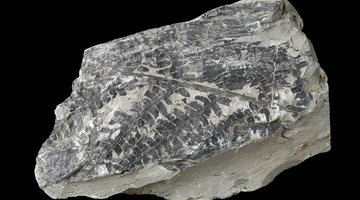Ferns come in a variety of shapes and sizes and this interactive explores the diversity of form in New Zealand ferns. The fern body consists of 3 major parts – the rhizome, the fronds and the sporangia. Click on the labels for more information.
Find out more about the sporangia in this related interactive.
Go here to view the full transcript and copyright information.

Ferns come in a variety of shapes and sizes and this interactive explores the standard structure of a New Zealand fern. Click on the labels for more information.
Transcript
Rachis
The central midrib or stalk of the lamina. It is a continuation of the stipe. Often the rachis differs from the stipe, both in colour and covering of hairs and scales.
Image acknowledgement: The University of Waikato Te Whare Wānanga o Waikato
Pinnae
The basic divisions of the frond. Pinnae or leaflets may be arranged alternately or in opposite pairs along the midrib. If the frond is once divided, then it is 'pinnate'. More commonly fronds are divided into secondary pinnae and are 'bipinnate', or into tertiary pinnae and are 'tripinnate'.
Image acknowledgement: Steve Attwood
Koru
A young fern frond produced from the rhizome. These are characteristically tightly coiled for protection and may be further protected with hairs or scales. Also known as fiddleheads, they uncoil slowly as they mature.
Image acknowledgement: Museum of New Zealand Te Papa Tongarewa
Rhizome
The stem of the fern plant. This may creep along or under the ground or even up a tree (a creeping rhizome), it may grow into a short or tall trunk (a vertical rhizome), or it may be a solid mass that gives rise to a tuft of fronds (an erect rhizome). Very often, the rhizome grows underground. The rhizome produces roots and new fronds.
Image acknowledgements: The University of Waikato Te Whare Wānanga o Waikato, Museum of New Zealand Te Papa Tongarewa
Stipe
The section of stalk between the rhizome and the lamina. The stipe varies in texture, firmness, thickness, length and colour and sometimes has a groove on the upper surface.
Image acknowledgement: The University of Waikato Te Whare Wānanga o Waikato
Frond
The leaf of a fern. These are called fronds to distinguish them from the leaves of flowering plants. Leaves in flowering plants are purely concerned with photosynthesis whereas fern fronds have both a photosynthetic function and a reproductive function. Each fern plant may have from one to many fronds. They may be as small as 1 cm (filmy ferns) or as large as 5 m (mamaku/black tree fern).
Image acknowledgement: Museum of New Zealand Te Papa Tongarewa
Lamina
The lamina is the flat, green leafy blade of the frond. The lamina includes the rachis (midrib or stalk) and the pinnae (leaflets).
Image acknowledgement: Museum of New Zealand Te Papa Tongarewa



